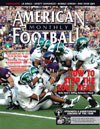AMERICAN FOOTBALL MONTHLY THE #1 RESOURCE FOR FOOTBALL COACHES
Article CategoriesAFM Magazine
|
Shutting Down the Zone OptionHow Delta State was able to completely stifle one of the most potent schemes in football.by: Mike Kuchar © More from this issue Delta State head coach Ron Roberts knows the zone option. He sees it every week. Like most other conferences in college football, the Gulf Coast, a Division II conference, has become filled with teams who invest in running some form of option out of the spread. In fact, eight of the ten programs in the Gulf Coast are pure option teams. Whether it be zone, veer, midline, dart or speed option, chances are you will see some form of it. “We see it all, a little bit of everything to tell the truth,” said Roberts. “As a matter of fact, our scout teams have become brilliant in running it every week because they are forced to do so.” But what separates Roberts and his staff at Delta from other programs that see the option is he knows how to shut it down and shut it down with consistency. The Statesmen finished 2007 with a 10-2 overall ....The full article can only be seen by subscribers. Subscribe today!
|
|
|||||||
| HOME |
MAGAZINE |
SUBSCRIBE | ONLINE COLUMNISTS | COACHING VIDEOS |
Copyright 2025, AmericanFootballMonthly.com
All Rights Reserved





